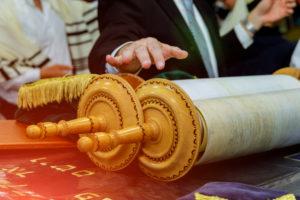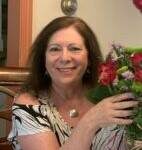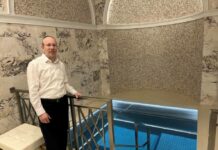
By Rabbi Ron Symons
Parshat Noach
I write these words as I contemplate when I might take down my sukkah at the end of Sukkot. I love Sukkot for the natural elements that make it a unique fall harvest, for the spiritual impulses that allow us to invite guests of ages past into our sukkah and for the spiritual practice of waving lulav and etrog.
Most importantly, I love Sukkot because I get to build a sukkah. Our sukkah design at home is one that was influenced by the sukkah I grew up in in Temple Emanu-El of Lynbrook, New York. That sukkah, centered in our temple’s biblical garden, was expertly constructed of lattice and 2-by-2 lumber, stained a dark brown, without a wayward piece of lattice to be found. Wherever I have tried to duplicate that sukkah, in our childhood home and then our family homes in New York, Boston and Pittsburgh, I have never succeeded in making our sukkah as pristine as that childhood prototype.
Don’t get me wrong, I love our sukkah and its predecessors, not because of the design — although I am proud of its Lynbrook origins — but because of the shared effort it has taken over the years to design it, build it, assemble it, unassemble it and store it until the next Sukkot. Over the years, all of us in the family have taken part in building, assembling and decorating. I learned that process, too, from Temple Emanu-El where everyone from religious school to youth group, to sisterhood, to men’s club would help year after year as we prepared for Sukkot.
And now, with Sukkot behind us, we have two examples of building projects in this week’s Torah portion, Noach. Both the building of the ark and the Tower of Babel sit in a deep place of collective memory, even for those who have limited exposure to the Bible. Both projects required individuals to transform the world around them to survive and better suit their needs.
That’s where the similarities end. After all, the ark was built by one man as his neighbors mocked him for decades while the tower was built by an entire community. The project of building the ark appeared to succeed by protecting the animals and Noah’s family from the waters of the flood; but it only protected them, and not his neighbors. They, alone, lived to see the world the day after the rain stopped.
The project of building the tower appeared to fail when God expressed frustration with it because of the monolithic nature of communication. Ultimately, humanity was dispersed across the earth and across languages so that we could not rise up together again in one voice.
How sad for us? Our attempt to make a name for ourselves and to rise to heaven was thwarted way back when, even as we might strive for unity of humanity today. It seems like the message of the Tower of Babel is that we should not try to work together.
That’s what I thought until I came across the wisdom of Rabbi Mary Zamore, executive director of the Women’s Rabbinic Network, an affiliate of the Central Conference of American Rabbis.
Now I see the Babel text differently. In contrast to their living as 70 different nations, the humans were able to create peace and harmony among themselves only when they were united by place, language and mission. God foiled their plan and scattered them — and us, their descendants — to send a strong message, one still needed today.
True peace, true unity lies in respectful diversity. The answer to the pre-flood human-against-human violence is not evolving into a homogenous unit; only when we learn to co-exist as different nations, cultures, religions, lifestyles and languages will we find true peace.
Her embrace of diversity as a message of the Tower of Babel was echoed by Rabbi Lord Jonathan Sacks when he wrote, “… they are attempting to frustrate God’s command in Genesis One, ‘Be fruitful and multiply and fill the earth.’ They attempt to concentrate in a city. And we have this critique throughout the Bible of urban civilisation.” The goal of creation was always for us to spread far and wide and live diverse lives.
The truth is that when we arrived to “build” the sukkah at Temple Emanu-El, it was already built. You see, Charlie, the Temple caretaker, and his diverse staff of non-Jews had already built the frame. The job of the young and old, inexperienced and experienced, was to put the corn stalks on the walls and the roof. We built that sukkah year after year on a foundation of diversity. That’s how we need to build community today, tomorrow and the next day.
Rabbi Ron Symons is the senior director of Jewish life and the director of the Center for Loving Kindness at the Jewish Community Center of Greater Pittsburgh. This column is a service of the Greater Pittsburgh Rabbinic Association.





